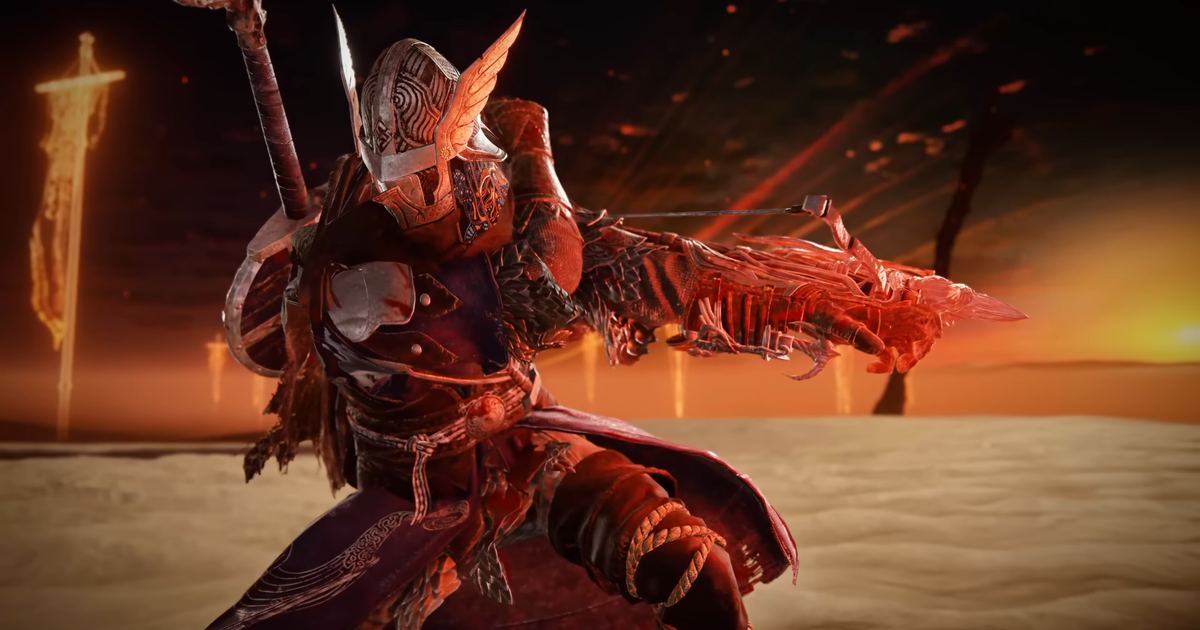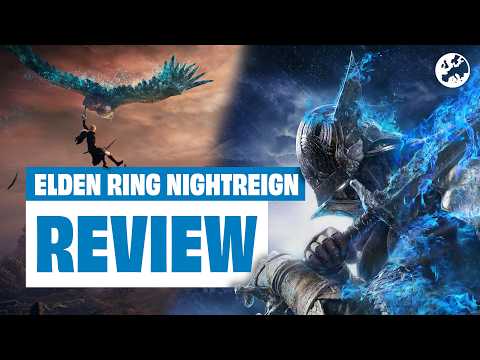The first boss is a real hurdle. I’m not talking about the tutorial boss – you’re meant to fail at that one – but the first true boss. The Tricephalos Nightlord is a fiery cerberus with a chain whip, who splits into three separate dogs to chase you down. You can’t progress until this overgrown puppy is downed, proving a big challenge early on. But isn’t this sort of block always the Dark Souls way? It just shows how Nightreign is an authentic Souls experience. I wouldn’t have it any other way.
This time, though, you’re not facing bosses alone but in a group of three playing together online. While FromSoftware’s previous games have included co-operative play, it’s never been mandatory. In Nightreign, you team up to explore a map with randomised elements. You spend two in-game days here, buffing stats and abilities before facing one of eight Nightlords on the third day. Fail and you start the run again. In this way, it combines the soulslike and roguelike genres – two buzzwords that have seemingly dominated the industry for the past decade. Here, though, it’s a multiplayer concoction only FromSoftware could have created. It’s intense and exhilarating stuff.
You can ignore those genre descriptors, though. Really, Nightreign is a game about sharing memorable moments with others: moments of wonder, comedy, frustration, and euphoria. Seeing a volcano erupt mid-game for the first time. Being stuck in an underground maze as a storm of death sweeps over the map. Joining up with players around the world and joyously shouting in multiple languages after absolutely nailing a tricky boss. The time my front door went in the middle of a Nightlord battle and I couldn’t pause, leaving my teammates to survive alone (we still won the battle). And, of course, the elation at finally putting that flaming puppy in its place. These sorts of shared moments are what all the best multiplayer games are about, and that’s what makes Nightreign so equally compelling.
Let me explain how it all works. Players fly into the map and must spend an in-game day exploring and levelling up as fast as possible. Gradually, a blue storm of death encroaches on the map, funnelling players towards a singular spot to defeat a boss. Survive and it’s on to day two to repeat the process on the same map. Survive that and it’s on to the Nightlord battle. The map itself is static, but certain locations, items, and bosses are randomised each time. Plus there are environment-altering instances and random invasions to keep runs fresh. The encroaching storm adds a dash of Fortnite, its purpose to keep exploring players close together, but often useful items – or even your dropped Runes upon death – can be left agonisingly out of reach.
There are eight Nightfarers to play as, each loosely based on a class from the original Elden Ring. There’s the all-rounder knight Wylder, the black mage Recluse, or the defender bird-man Guardian, to name three. Each has their own skills with which to approach combat, as well as an ultimate attack to unleash. Take Wylder for instance: his clawshot is used as a grappling hook to dominate combat, while his ultimate attack has explosive force to stagger bosses. I love how the characters are not only distinct to play as, but had me rethinking old strategies from Elden Ring. I never once used a bow in that game but, having spent a lot of time as archer Ironeye in Nightreign, I’m now considering a new playstyle. The complex mage characters, however, are the real hard mode.
Character skills are one way FromSoftware has encouraged co-operation. Through practice, these can sync up in exciting ways to make or break a boss battle. The Duchess, for example, has a rewind ability to repeat the last few moments of damage from any player – particularly useful after an ultimate or critical hit. What’s more, if another player is downed they can be revived when struck by other players, meaning it’s not only beneficial to stick together, but ultimate attacks can be used more defensively too, adding to strategy.
Nightreign does include a single-player mode for the truly sadistic, but it’s best experienced in a group on voice chat, bickering about where to explore next, exchanging strategies, and sharing defeats and wins alike. Matchmaking will team players up together and a basic ping system can be used to highlight areas of the map, but proper vocal communication really is key to defeating the Nightlords. Their sweeping AoE attacks and charges across battlefields are geared towards three players (there’s currently no two-player mode) and strategies to align moves at just the right time are often required. Nightlord battles sometimes feel more like MMORPG raids with certain mechanics I won’t spoil here.
Finding teammates relies on matchmaking online, though, and in typical FromSoftware fashion, playing online has its struggles. During the review period, joining up via password or PSN friend ID often failed and matches sometimes had heavy lag and stuttering (beyond sometimes choppy performance). It never truly impeded on a successful run, but reliable matchmaking is essential in any multiplayer game and is something I hope FromSoftware will seek to improve post-launch. More crucial is the lack of crossplay, meaning you can’t play together with friends on rival platforms – a huge oversight.
Once in a match, though, Nightreign is a rush. It feels like speed-running Elden Ring in half hour bursts, containing a microcosm of exploration and combat before surmounting the challenge of a colossal boss battle. It’s a particularly demanding experience, especially for its sheer speed that rewards quick thinking and instinctive reactions. With the constant threat of the blue storm, there’s a real urgency to managing priorities, frantically swapping strategies on-the-fly, and maximising your chances of team success. There’s a pleasing scrappiness to movement too, as you scramble up cliff faces with new parkour abilities, speed across fields with a hasty sprint towards the next nightmarish boss, and leap from mountains in a last ditch attempt at escape thanks to the lack of fall damage. The map is a playground full of secrets to uncover over multiple runs, while combat itself is just as biting as Elden Ring.
Early-on it’s easy to feel overwhelmed by the breadth and depth of the map with all its varied locations and unexplained icons; Nightreign is as abstruse as ever, though that further adds to co-operation in sharing knowledge. Learn its intricacies, though, and strategies unfold. It feels particularly satisfying to gain full understanding of the map, but as a result runs eventually devolve into following the same optimum path as the lack of map changes become stale. Random events aren’t quite as frequent as I’d like to shake up gameplay, but at least if weapon and buff rolls are against you, skill always wins out.
Thankfully, no run is truly wasted. Each attempt is rewarded with Relics, which provide passive buffs once applied to your character in one of three slots; while a permanent currency is used to purchase new Relics, or unique costumes for the Nightfarers once unlocked. Relics allow for more detailed build crafting with a major impact on the success of a run, though acquiring them at random can feel like a grind. Each character has a story of sorts too, with journal entries leading to special missions called Remembrances – collecting a certain item, or defeating a certain enemy – to progress the questline. This is by no means a narrative-driven game, but Remembrances add to the overall feeling of progression and provide some very useful unique rewards.
In all, Nightreign feels like a thank you to the 30 million players who bought the original Elden Ring. It uses repeat assets from the game and the bosses encountered are taken from across Elden Ring and the three Dark Souls games, while the eight Nightlords are all brand new and rank among some of the most difficult yet beautiful bosses FromSoftware has created. As such, Nightreign is a celebration of the Souls series for veterans already versed in its calculated combat and able to spot familiar demonic faces. It’s as close to a party as this sombre, monstrous series of games will ever be. But that’s at the expense of newcomers, who may struggle with its fast pace. Nightreign is outstanding for fans, but has limited appeal for the wider gaming community, though I’d urge anyone with an interest in Elden Ring to try it.
I don’t expect Nightreign to compete for time with established online multiplayer giants, then. But what’s here is a brilliant foundation for a longterm game, if only FromSoftware would support it as a live service beyond its forthcoming DLC. Am I being greedy? Probably. But Nightreign has so much long-term potential, through adding more Nightlords, more Nightfarers (and costumes), more randomised map events. While I bemoan developers for chasing live-service trends – and we’ve seen plenty fail – Nightreign deserves to be a hit. It’s proven to me, a staunch solo player, that multiplayer Souls can be just as fun, just as challenging, and just as satisfying when played together. After beating that cerberus, I went back to help a fellow player defeat it too and shared in their elation when we won together. What a thrill! After all, a problem shared is a problem Souled.
A copy of Elden Ring Nightreign was provided for review by Bandai Namco.

